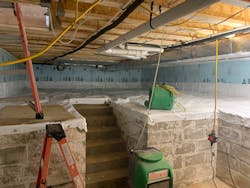Help Space-Strapped Homeowners: Convert the Crawlspace to a Basement
Crawlspaces, though they require extensive site planning and proper drainage, can be converted into full basements.
Homeowners today are looking for inexpensive ways to add more space. Instead of building an addition, some homeowners may want to add a basement to a house by converting a crawlspace into a full basement. A crawlspace conversion is a relatively complex project, though, so contractors must take enormous care with site planning and proper drainage.
How do you dig a crawl space into a basement?
In most cases, says Vladimir Kochkin, director of applied engineering for the NAHB Research Center, the contractor would have to replace the existing foundation completely with a new one built per code. The existing structure would have to be temporarily supported either in parts or in its entirety while the foundation work is being done, and, says Kochkin, the new basement would have to comply with all local building code requirements for drainage, wall and footing construction. "To be honest, I am not sure it is a good idea to try to convert a crawlspace into a full basement," Kochkin says of digging out a basement.
Carl Seville, LEED AP Homes and owner of Seville Consulting, echoes Kochkin's concerns. Digging out a basement under an existing house raises serious safety challenges, he says, adding, "If the total excavation is less than four feet you can avoid shoring the area, if more it becomes very difficult to do it legally; it has to be dug out and new footings and walls poured in short sections to avoid endangering employees by having them work next to a tall cut dirt wall," he says. "People do this all the time, but it usually is contrary to OSHA regulations."
RELATED: Placing a Concrete Foundation in One Pour
Seville says the first and foremost concern is the soil. Hard, stable soils such as some clays can be cut almost vertical with minimal chance of failure. Sandy and soft soils need much shallower slopes. Drainage, Seville says, is next. "Where can you drain the foundation water? Can you install a gravity drain to grade or will you need a pump?"
Existing foundations also present some challenges. In all climates, it is critical to have the new walls waterproofed and install drain tile to daylight or a sump. There is often not enough room to waterproof on the outside of the new wall between it and the dirt, says Seville, so interior drainage — installing the type of waterproofing that is typically installed as a retrofit in an existing basement — may be most appropriate for digging out a crawlspace.
"If the idea is to attempt to preserve the existing foundation for any reason like a historic home, it would add another level of complexity and would require a special design effort," says Kochkin. Otherwise, he says, with proper planning and egress built in, the rest of the work is little different than a standard basement and many of the same building products can be used.
Proper HVAC equipment, particularly humidity management, is paramount. Depending on the climate it may be very damp but cool in a basement, which will require dehumidification much of the year," says Seville.
"I have seen plenty of crawlspaces built of double the brick, no footing, sitting on virgin soil. If there were no water problems, the foundations were perfectly stable 100 years later," says Seville. While he doesn't recommend under-building, he says that contractors do tend to overbuild. "I believe that all foundations should be designed to the minimum requirements taking into account the existing soil stability, lateral pressure and hydrostatic pressure. Too many buildings are designed using standards that basically are big enough to avoid lawsuits as opposed to right sizing them for the site," says Seville.
